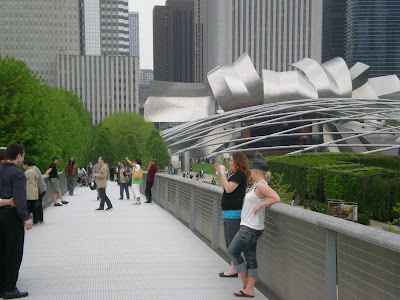The Nichols Bridgeway
Heavy rains through most of the morning, which might be fitting for Towel Day. Today is also the 50th anniversary of President Kennedy's famed call to send a man to the Moon by 1970. An audio of the speech is here, one that's is longer than the usual sound bite. Interestingly, the president asked for money not just for going to the Moon, but two other space ventures as well: a nuclear-power rocket called Rover, ultimately shelved in the early '70s, and weather satellites, which have proven themselves tremendously useful over the last five decades.
Seems like a lot of special things happened 50 years ago. Clearly, 1961 was quite a year.
After Robert's graduation from the School of the Art Institute last Saturday, we figured the thing to do was go to the Art Institute and look around. Even better, his status as a newly minted alumnus provided all of us with free passes, except for Lilly and Ann, who still don't need to pay to get in.
From the Great Lawn of the Pritzker Pavilion, one way to reach the Art Institute is via the steel Nichols Bridgeway, which begins at ground level, slopes up over Monroe St., and connects to the third floor of museum's Modern Wing, where there's a restaurant. You have to go down again to reach the collection of modern art in the Modern Wing.
Though the bridge has been open for about two years now, this was my first crossing. This is what it looks like from the ground.
And this is from roughly the mid-point of the bridge, looking back at the Pritzker Pavilion, with its distinctive Frank Gehry curlicues. It's a wide structure, the better (I guess) to make pedestrians more comfortable with the three-story rise.
Renzo Piano, architect of the Modern Wing, designed the bridge too. Tribune architecture critic Blair Kamen wrote: "Piano's bridge is a straight shot, consisting of curving steel sections that are welded together to resemble the hull of a racing yacht -- or, as wags would have it, the world's longest gutter. Sealing the nautical metaphor, Piano, who like many architects is an avid sailor, gave the bridge delicate, prow-shaped ends... from above Monroe, you can gaze out at the blue waters of Lake Michigan or through the skyscraper canyons of the Loop. At the end, you survey the sunken commuter railroad tracks that bisect the Art Institute. They are a vertiginous 50 feet below."
I also want to mention the bridge's engineers. Architects often enough get a mention, but not so much engineers. For this work, two firms won an award of merit for the work in 2009 from the Structural Engineers Association of Illinois: Ove Arup and Partners Ltd., who did the bridge superstructure, and Wiss, Janney, Elstner Associates, who did the substructure.
Labels: architecture, Chicago, space exploration




0 Comments:
Post a Comment
<< Home